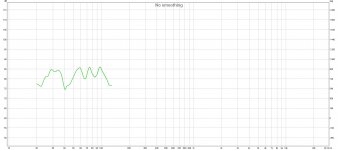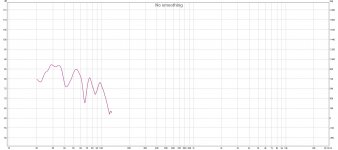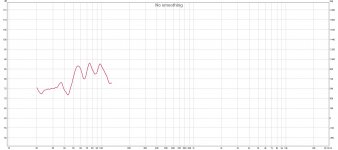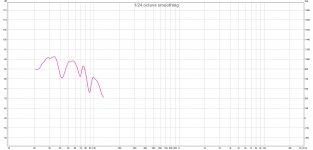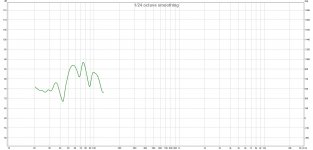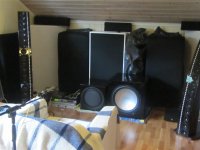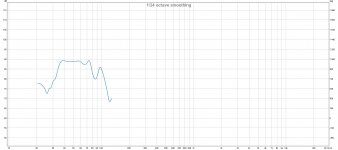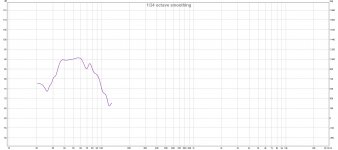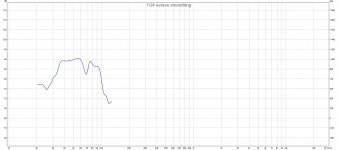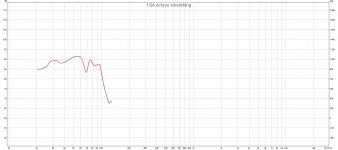Why am I getting a null when I'm running two subs?
Here's how they measure separately.

And second:

When I run them together, this is what I'm getting:

So what's happening? The bass between 25-35 Hz is gone.
I've placed them both in the middle of the width of the room.

Here's how they measure separately.
And second:
When I run them together, this is what I'm getting:
So what's happening? The bass between 25-35 Hz is gone.
I've placed them both in the middle of the width of the room.
Attachments
Have you tried playing with the phase switches? Try a measurement with one then the other then both switches just for fun to see what happens. I'd also try moving them away from each other.
It's possible that the LF filters for the two sub-woofers are acting on the time delay of the subs differently. Therefore at some frequencies the outputs may be in phase whereas at other frequencies they may be out of phase.
Sorry. Been occupied.
I haven't tried changing the phase. I will play with that and report back. Thanks for the suggestions.
I haven't tried changing the phase. I will play with that and report back. Thanks for the suggestions.
Sorry. Been occupied.
I haven't tried changing the phase. I will play with that and report back. Thanks for the suggestions.
I may have missed it, but you should try changing the position of one (or both) of the subwoofers and measure the difference. IOW: you don't want symetry in the room.
I measured them individually first, moved them around and both measured best in the middle of the width of room.
Sorry. Been occupied.
I haven't tried changing the phase. I will play with that and report back. Thanks for the suggestions.
Tell us more about those two subs, e.g. are they sealed, or vented?
Unless you are outside over 30 feet in the air, you will have nulls. Physics.
Two or more sub lets you distribute nulls around so maybe, with effort, you won't have too many really deep ones.
Now, how to get rid of them? Bass traps. Real ones, not little foam wedges. Next tip: don't get too carried away with measurements. Listen. You don't hear LF issues like you do higher ones.
Two or more sub lets you distribute nulls around so maybe, with effort, you won't have too many really deep ones.
Now, how to get rid of them? Bass traps. Real ones, not little foam wedges. Next tip: don't get too carried away with measurements. Listen. You don't hear LF issues like you do higher ones.
It is a whole octave wide. An odd room and/or mic effect. Worse things sometimes show up in testing. What kind of test signal?
Just find a good set of locations for the two subs and you are good to go. I am a big believer in heterogeneous locations (say corner and mid-wall) to blend the various factors of the room and speakers (like thinking statistically about sound rather than thinking determinatively).
Ben
Just find a good set of locations for the two subs and you are good to go. I am a big believer in heterogeneous locations (say corner and mid-wall) to blend the various factors of the room and speakers (like thinking statistically about sound rather than thinking determinatively).
Ben
Last edited:
Unless you are outside over 30 feet in the air, you will have nulls. Physics.
Two or more sub lets you distribute nulls around so maybe, with effort, you won't have too many really deep ones.
Now, how to get rid of them? Bass traps. Real ones, not little foam wedges. Next tip: don't get too carried away with measurements. Listen. You don't hear LF issues like you do higher ones.
This looks more like phase canclation. I don't think bass traps will solve this problem. Looks like one is out of phase. Try messing with that and add another sub for better smoothing. When that is fixed, then you can go back and measure decay time, then fix that with good traps.
The small one is an 12" Geddes bandpass sub. The other one is an 18" sealed eD sub.Tell us more about those two subs, e.g. are they sealed, or vented?
Ok. I changed the phase from 0 to 180 on the eD sub. Here's how they measured simultaneously with the phase first at 0 (as before):
Then changed the sealed eD sub to 180:
So that seems to have sort it out. Measuring the big eD sub alone with 0 phase it measured fine, but as soon as I ran i together with the bandpass sub I got a null. There's less bass now at 90-100 Hz compared to the green graph (bandbass sub) in first post, but that's due to moving the sub some and more basstrapping behind the sub. Yeah I know, it's strange, the cancellation is actually stronger with more thick porous absorption right behind the sub. 40-55 cm of quite low density rockwool now on most of the front wall. I moving towards pressure based traps........
My question now is; Is this enough or do I need to further work on phase allignment? I have Behringer DCX2496 which I believe can dial in phase more precisely. How do one phase allign with both other subs and with the fronts?
Attachments
Is one sealed and another vented if so thats the issue and the tuning is likely around 40Hz where phase goes positive to negative.
With the reversed phase, that rising low bass curve is about as nice as anyone could ask for in real rooms. It will likely sound flat and wonderful. Once you check out heterogeneous room locations for the two subs, you might get those other bumps to behave better.
How are you measuring?
B.
How are you measuring?
B.
I've borrowed these subs from my hometheater as a temporary solution. The plan is to get someone build me two towers of something called hybrid dipole. Basically means one can change the dispersion as different frequencies. Dipole, cardiode, bass-reflex and sealed can work at different frequencies. This may help me level out the response some besides better treatment and placement.With the reversed phase, that rising low bass curve is about as nice as anyone could ask for in real rooms. It will likely sound flat and wonderful. Once you check out heterogeneous room locations for the two subs, you might get those other bumps to behave better.
How are you measuring?
B.
I'm measung with a calibrated Dayton mic and using REW software. I don't check the level everytime but it's around 80-85 dB.
The mic is at ear height and faced towards the speakers as the picture shows.
Attachments
Why get two of the same kind?
Of course, I ask the same question about matching silverware.... or stupidly identical matched knobs and meters in a nuclear power plant control room (DAMHIK).
Ben
Of course, I ask the same question about matching silverware.... or stupidly identical matched knobs and meters in a nuclear power plant control room (DAMHIK).
Ben
Last edited:
Because of the flexibility of hybrid dipole, they really don't need to function as equal subs. The dispersion can be altered.Why get two of the same kind?
Of course, I ask the same question about matching silverware.... or stupidly identical knobs and meters in a nuclear power plant control room (DAMHIK).
Ben
But why get something that looks the same? For aesthetic reasons I guess.
Moved the small sub to the back of the room. Getting some nice responses here. All are measured with one at different loactions. The crossover is set to 80 Hz by the way.
Is it possible to integrate the sub seamingless when it's placed behind the listener?
Is it possible to integrate the sub seamingless when it's placed behind the listener?
Attachments
Time to get the mid-range running. With that last curve, you might have a vile loud bassy quality in the 80-120 region (which why the rising bass earlier might sound better). But that kind of final tuning is best done by ear since these traces mean surprisingly little for fine-tuning.
BTW, it is the consensus around here that a a rising bass is needed to sound right, not some kind of flat-looking textbook curve.
B.
BTW, it is the consensus around here that a a rising bass is needed to sound right, not some kind of flat-looking textbook curve.
B.
- Status
- Not open for further replies.
- Home
- Loudspeakers
- Subwoofers
- Why I'm seeing a null with two subs?
